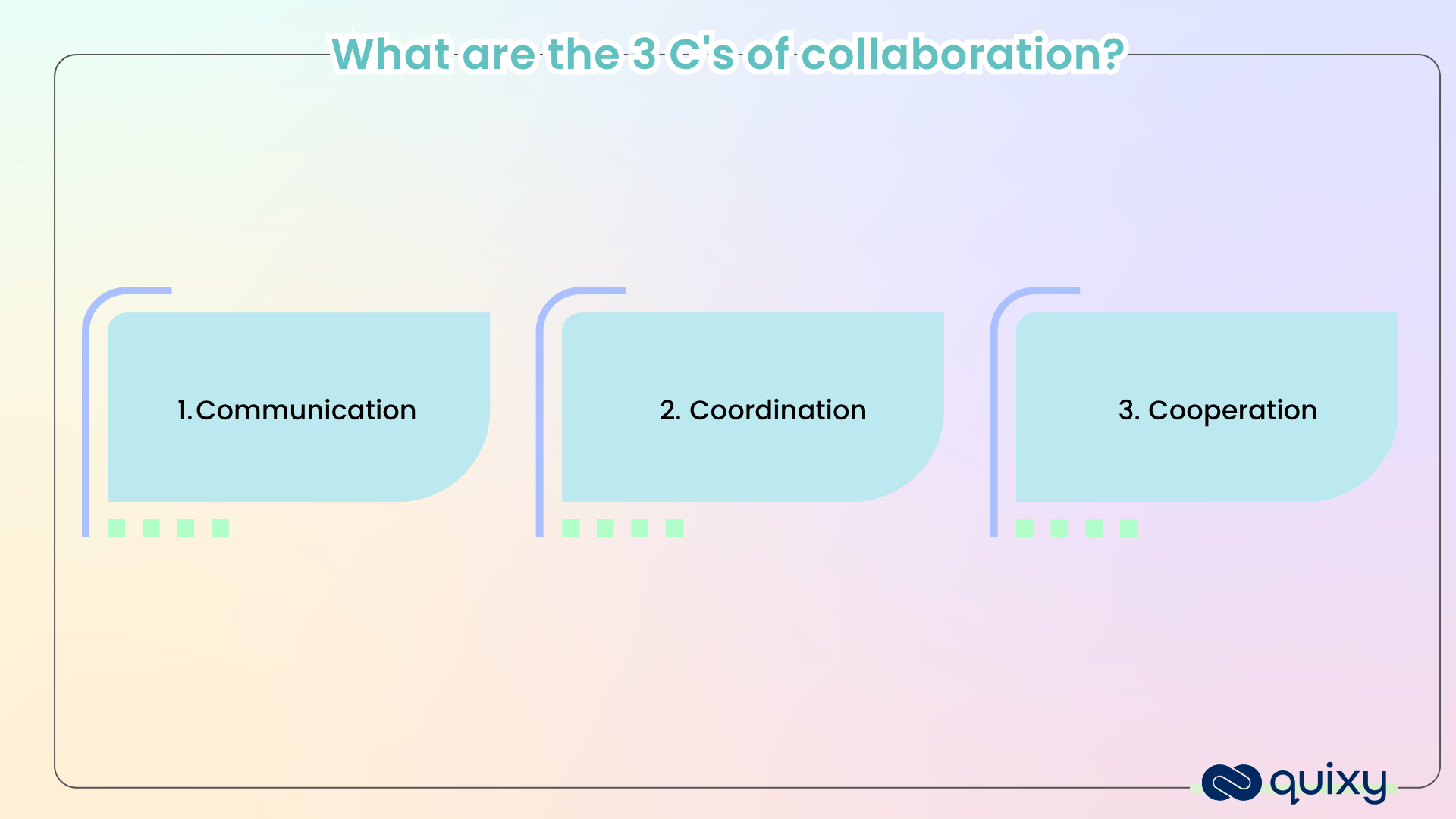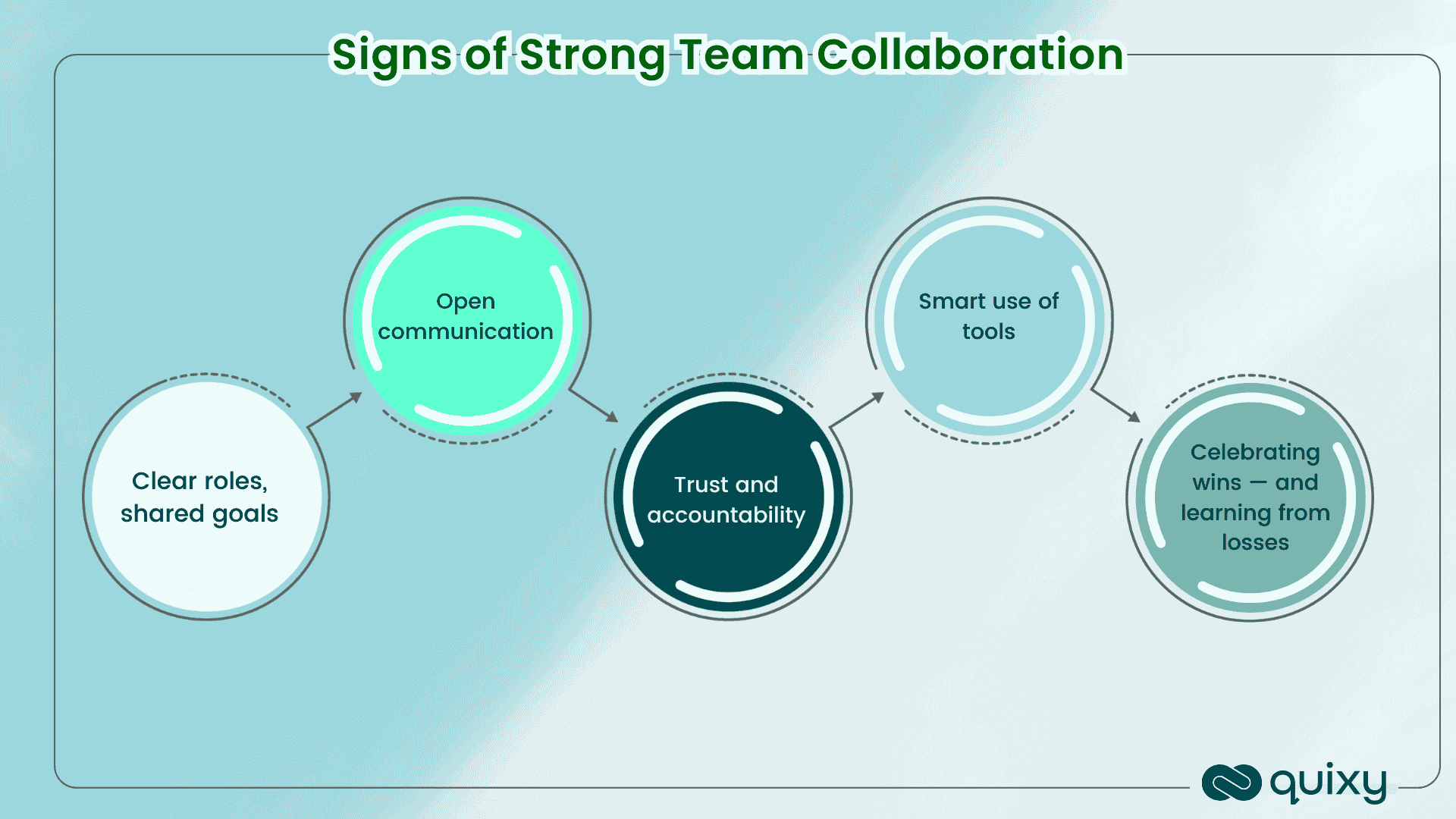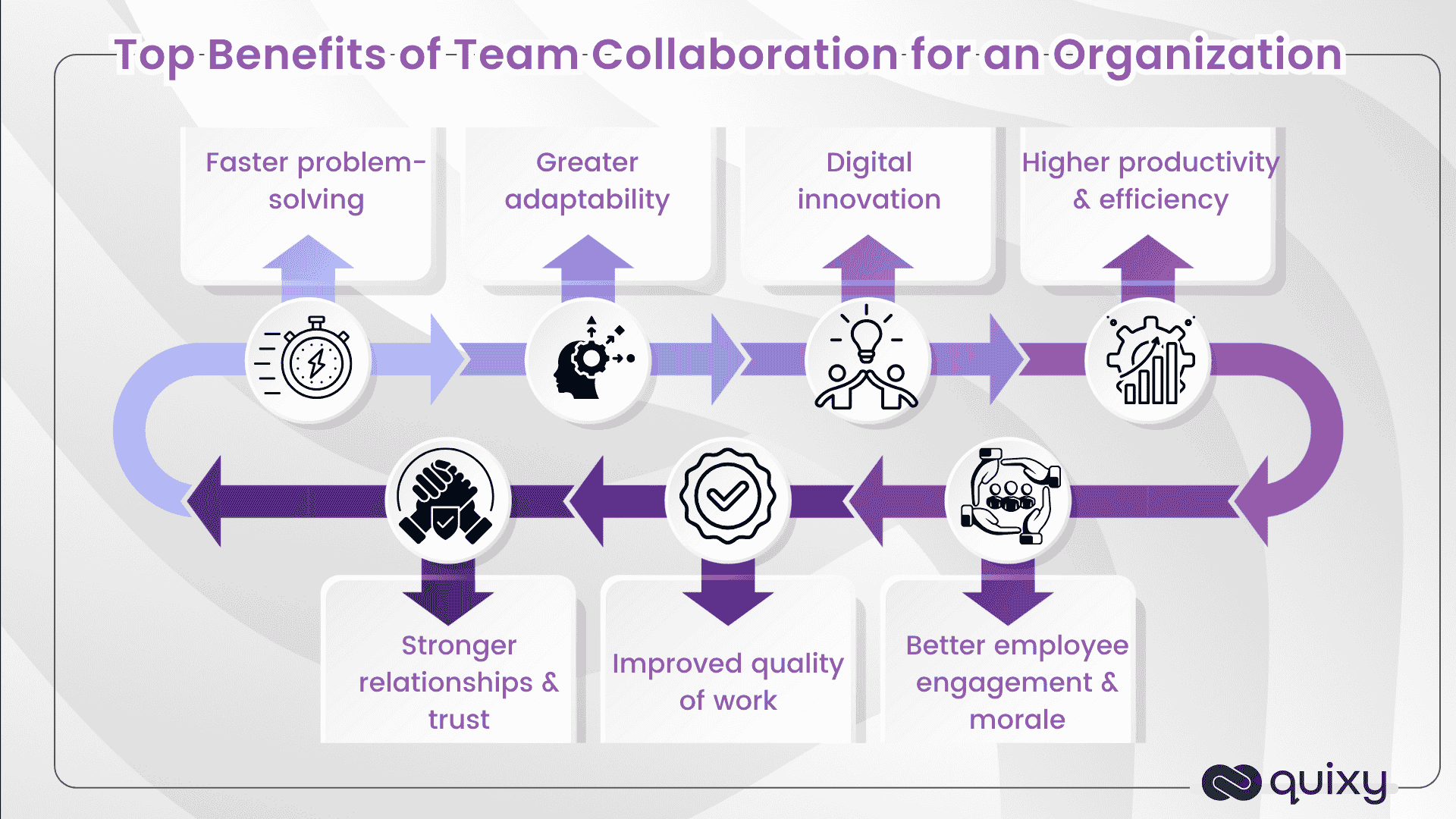
Organizations after organizations have realized this- their employees are the most important driver of their competitive advantage. This makes employee collaboration of the utmost importance, as it allows a bunch of talented professionals to bring in the best of their work and ideas and allows them to build on it. Therefore, today’s digital workplaces emphasize team collaboration and have systems to encourage and reward it. So, what benefits of team collaboration do organizations want to gain?
What is Team Collaboration?
Team collaboration is all about people working together to achieve a shared goal. It goes beyond just checking tasks off a to-do list — it’s about brainstorming ideas, solving problems, and supporting each other along the way.
At its heart, team collaboration is built on clear communication and trust. Whether it’s a quick Slack message, a spontaneous whiteboard session, or a virtual meeting across time zones, strong collaboration keeps everyone aligned and moving in the same direction.
When teams collaborate well, work feels smoother and more fulfilling. Ideas flow faster, mistakes get caught sooner, and everyone feels more engaged because they know their voice matters.
In today’s hybrid and remote work world, collaboration tools (like project management apps, shared docs, and instant messaging platforms) play a huge role in bridging gaps and helping teams feel connected no matter where they are.
Ultimately, great collaboration doesn’t just help you get work done — it empowers your team to do their best work together.
What are the 3 C’s of collaboration?

Communication
At the heart of every successful collaboration is strong, open, and honest communication. Team members should feel comfortable sharing ideas, asking questions, giving feedback, and raising concerns. Clear communication keeps everyone aligned and prevents misunderstandings from derailing projects.
Coordination
Good collaboration requires thoughtful coordination — making sure tasks, responsibilities, and timelines are clearly defined and well managed. This means having the right tools and processes in place so everyone knows who’s doing what, by when, and how all the pieces fit together.
Cooperation
Collaboration is ultimately about working with each other, not just next to each other. True cooperation means supporting teammates, respecting different perspectives, and working toward shared goals rather than personal agendas. It’s about building trust and putting the team’s success above individual ego.
Together, these 3 C’s — communication, coordination, and cooperation — help teams achieve more, innovate faster, and create a culture where everyone feels empowered to contribute their best work.
The Real Signs of Strong Team Collaboration

Good team collaboration isn’t just people working in the same room (or Zoom call). It’s when everyone’s talents, ideas, and energy come together seamlessly — like a well-practiced band playing in sync.
Here’s what it really looks like in action:
✅ Clear roles, shared goals
Everyone knows what they’re responsible for and how their work fits into the bigger picture. There’s a shared mission — and each person feels like a key part of it.
✅ Open communication
Ideas, feedback, and updates flow freely. Team members feel safe speaking up, asking questions, and even disagreeing — respectfully, of course. The best ideas often come from healthy debate.
✅ Trust and accountability
No micromanaging. Just trust that everyone will deliver on their part — and offer support when someone hits a bump in the road.
✅ Smart use of tools
Whether it’s task boards, real-time docs, or messaging apps, the right tools help everyone stay aligned without drowning in meetings or emails.
✅ Celebrating wins — and learning from losses
A collaborative team takes time to appreciate progress, big or small. And when things don’t go as planned? They reflect together, adjust, and keep moving forward.
In short, good team collaboration feels productive, energizing, and genuinely human. It’s where great work — and great culture — thrives.
Top Benefits of Team Collaboration for an Organization

Faster problem-solving
With everyone sharing ideas openly, challenges get tackled quicker. Teams can brainstorm solutions in real time instead of working in silos and wasting time.
Higher productivity and efficiency
When people work together smoothly, there’s less duplication of effort and fewer roadblocks. Teams can move faster toward shared goals.
More innovation
Collaboration sparks creativity. Different perspectives come together, leading to fresh ideas and breakthrough solutions that might never come from one person alone.
Better employee engagement and morale
People feel more valued and connected when they have a voice and a sense of ownership. A collaborative environment boosts motivation and job satisfaction.
Stronger relationships and trust
Working closely builds bonds. Team members learn to rely on each other, leading to a stronger, more supportive workplace culture.
Improved quality of work
When teams review, refine, and build on each other’s work, the final output is usually more polished and effective.
Greater adaptability
Collaborative teams can pivot and respond to changes faster, helping organizations stay competitive in a constantly evolving market.
The list of benefits of team collaboration can go on, but it is also important to tackle the issue of effective collaboration. Cross-team collaboration or virtual collaboration will only help an organization if done effectively. Let’s first understand the pitfalls that hamper successful collaboration.
Also Read: Top 10 Characteristics of Effective Teams that Outshines in an Organization!

Hurdles you might find in the way
Team size is one of the first hurdles to successful team collaboration. Technology has allowed teams to expand like never before. However, an HBR study found that when the size of any team becomes more than 20, the tendency to collaborate naturally decreases. Remote working also hurts the quality of collaboration. This was especially true for organizations that failed to build a strong collaborative culture, and the pandemic could affect the same.
While a high amount of diversity among team members increases the value of their collaboration, it can also hinder it. If there are too many strangers on a team, or some members view others as “alike” and “different”, it leads to faultlines in teams that make it very difficult for all the members to be a cohesive unit. It is also noticed that if team members’ education levels are high, they see each other more as rivals and less as people they can collaborate with. The more experts, the higher the risk of conflict in the team.
So, in light of these pitfalls, what can organizations do to ensure effective collaboration and reduce the chances of these obstacles coming the way?
Tips to Build Team Collaboration effectively
1. Senior leadership to Advocate
The most essential step in establishing a collaborative culture is ensuring the buy-in of the senior leadership. They must build strong relationships to spread the message to others. They can also facilitate collaboration through organizational practices and shared infrastructure. Senior leaders should also take part in active mentoring and rewarding the right behaviour.
2. HR to create People’s Culture
The next biggest stakeholder is the HR department, as it can design formal policies that encourage and prepare people to collaborate. HR is a key enabler from performance management systems with the right incentives to training to forming cross-departmental collaborative teams. HR can also check the competency for collaboration and interpersonal skills for important teams while hiring.
3. Effective Leadership style
There are broadly two types of people in teams- task-oriented and relationship-oriented. As the name suggests, a task-oriented leader would emphasize producing the desired results and judge a group’s success based on targets. On the other hand, the latter focuses more on creating a positive working relationship among team members and looks to enhance their satisfaction and motivation. As it is very apparent from their descriptions, both these leadership styles can not exist in isolation. Different contexts require different kinds of leaders to step up, and therefore both are needed to be in cross-functional collaborative teams to make it work.
4. Individual Accountability
Another essential aspect to consider is establishing individual accountability and clarity for all the team members. Collaborative teams have the possibility of some members falling into the habit of social loafing, which would increase the workload on the other team members and lead to a dysfunctional working environment. Therefore, both group and individual success metrics need to be set up.
5. Fostering Fresh Idea
One of the most important tips for building team collaboration is to promote new ideas from the team members. Giving an open space to discuss will encourage free communication. A place where employees can express themselves freely will always have a better understanding of themselves.
Importance of Technology in Fostering Collaboration
Before the pandemic, simple things such as meeting people in the hallway or at the water coolers could aid collaboration and social connections. However, strengthening a culture of collaboration in the virtual setup is quite tricky. In such a scenario, technology tools become the absolute saviour. Many tools like Slack or Teams allowed organizations to work through the pandemic and ensured that collaborative groups faced as little disruption as possible. However, it is to move from essential video conferencing tools to more advanced ones.
Many organizations went a step ahead and invested and trained their employees in technology tools such as Kanban boards to improve work across human systems. The visual interface and tools are great for taking collaboration to the next level. Many project management tools and frameworks have made their presence dominant during the pandemic, allowing teams to stay on top of all that others are up to and add their inputs and status updates.
Tactics for Successful Team Collaboration
Strong collaboration doesn’t just happen — it’s built intentionally with the right habits and tools. Here are some practical tactics teams can use to work better together:
✅ Set clear goals and roles
Everyone should know exactly what the team is working toward and what their individual responsibilities are. This clarity helps prevent overlap, confusion, and unnecessary conflicts.
✅ Foster a culture of open communication
Encourage team members to share ideas, ask questions, and provide feedback — without fear of judgment. Create spaces (like regular check-ins or open Slack channels) where everyone feels safe to speak up.
✅ Choose the right collaboration tools
From project management platforms to shared document editors and instant messaging apps, the right tools make all the difference. Pick solutions that are easy to use and keep everyone on the same page.
✅ Embrace transparency
Share updates, progress, and challenges openly so everyone stays aligned. This helps build trust and keeps the whole team moving in the same direction.
✅ Encourage mutual support
A strong team looks out for each other. Celebrate wins together, offer help when someone is stuck, and make space for different working styles and strengths.
✅ Provide regular feedback
Constructive feedback helps improve both individual and team performance. Make it a normal (and positive) part of your workflow rather than something that only happens during annual reviews.
✅ Celebrate milestones and successes
Take time to recognize and appreciate the team’s hard work. This boosts morale and keeps everyone motivated for the next big goal.
When done right, these tactics create a foundation where collaboration feels natural, energizing, and effective — helping your team achieve more together than they ever could alone.
Also Read: 20+ Best Time Management Activities for Highly Productive Teams
Building a Collaborative Team Environment
We often expect teams to deliver great results, but that’s nearly impossible when people don’t work well together. A truly collaborative environment isn’t just nice to have — it’s critical for success. Here’s how teams can intentionally create it:
Have a shared purpose and clear goals
A team exists to achieve something together. Without a clear mission, there’s no real direction. To create this sense of shared purpose, define and discuss why the team was formed, set a vision everyone can get behind, and let each person commit to it in their own words. Reinforce this shared goal through team mottos, visual reminders, or regular check-ins that keep everyone focused on what matters most.
Build trust among members
Trust is the foundation of strong teamwork. It starts with honesty and transparency — avoid gossip, stay open, and assume positive intent when challenges arise. Show trust by giving colleagues the benefit of the doubt and supporting them rather than second-guessing their actions. Trust needs to be given before it can be fully received.
Define and clarify roles
When everyone understands their role — and how it connects to the bigger picture — the team runs more smoothly. Regularly revisit each person’s responsibilities, talk openly about expectations, and encourage teammates to learn what others do so they can better support each other. This clarity helps eliminate overlap and keeps the team agile.
Encourage open, honest communication
Strong communication prevents misunderstandings and strengthens relationships. Overcommunicate rather than assume people “just know.” Listen actively, clear up confusion promptly, and make sure everyone feels heard and valued. Recognize contributions openly to build a positive communication culture.
Celebrate and leverage differences
Diverse backgrounds and perspectives are a team’s greatest assets. Embrace different viewpoints, learn from each other, and evaluate ideas based on their value rather than who suggested them. Avoid making assumptions or highlighting differences negatively — instead, turn them into a strength that sparks innovation.
Balance focus on tasks and relationships
A great team keeps an eye on both the work and the human side of collaboration. Track progress on deliverables, but also pay attention to how people feel and interact. Celebrate milestones together, recognize both team and individual achievements, and check in regularly on group dynamics. Striking this balance ensures the team stays healthy and effective long-term.
Also read: What is Collaboration Software?
Must Haves for Team Collaborations
Successful team collaboration doesn’t happen by accident — it’s built on a few essential ingredients that help teams stay aligned, motivated, and productive. Here’s what every team needs:
✅ A clear, shared goal
Every team needs a north star. When everyone knows exactly what they’re working toward, it’s easier to prioritize, make decisions, and stay motivated.
✅ Open and honest communication
Transparent communication is the backbone of strong collaboration. Team members should feel comfortable sharing updates, raising concerns, and offering feedback — without fear of judgment.
✅ Trust and psychological safety
People need to trust one another and feel safe to speak up, make mistakes, and ask for help. This creates an environment where everyone can contribute their best ideas.
✅ Clearly defined roles and responsibilities
When everyone knows who is responsible for what, it prevents confusion and overlap. Clear roles help the team move faster and avoid unnecessary friction.
✅ The right tools and technology
From project management apps to shared document platforms and instant messaging tools, having the right tech stack is essential for smooth, seamless collaboration — especially in remote or hybrid setups.
✅ Commitment to accountability
Team members should be willing to own their tasks and support each other in reaching milestones. Accountability builds trust and keeps projects on track.
✅ Flexibility and adaptability
Plans change. Teams that can adapt quickly to new information or unexpected roadblocks are much more resilient and successful in the long run.
✅ Recognition and celebration
Celebrating wins (big and small) helps keep morale high and reinforces a sense of shared accomplishment. Acknowledging individual and team efforts goes a long way toward building strong bonds.
Also Read: Business-Led IT is crucial for your Business Success: Here’s Why!
Low-Code No-Code Platforms & Team Collab
Low-code and no-code platforms aren’t just about building apps faster — they’re powerful tools for bringing teams closer together.
By making it possible for anyone (even non-technical team members) to create and customize workflows, these platforms break down silos and invite more people to actively shape solutions. Teams can brainstorm an idea one day and see it come to life the next, without waiting on long development cycles or heavy IT backlogs.
This empowers employees to solve problems on their own, share feedback in real time, and continuously improve processes together. In the end, everyone feels more invested and connected — and the organization moves forward faster.
When teams have the freedom and tools to build what they need, true collaboration thrives.
Conclusion
The long-term benefits of team collaboration for any organization are immense; therefore, every organization aiming at success must invest heavily to ensure collaboration. There also needs to be a shift in the mindset of all stakeholders to make collaboration a priority and to remove any hurdles that the process might face.
Technology platforms are another important aspect for which organizations must be on the lookout. Tech revolutions such as no-code low-code platforms allow employees to do away with manual and repetitive tasks and focus their time on what matters the most. They can collaborate better because they have better bandwidth and morale. Such platforms also instill a culture of digital dexterity in organizations, allowing employees to make the most out of the technology at their helm.
Quixy’s award-winning no-code platform has enabled clients across industries and geographies to automate their processes without writing a single line of code. Take your business to the next level and build applications like never before with Quixy’s easy-to-use visual interface.
Don’t miss out on the chance to elevate your processes. Take the first step and get started with Quixy today.
Frequently Asked Questions(FAQs)
Q. Which is the best example of team collaboration?
A strong example is when cross-functional teams work together to build and launch a new internal app to streamline employee onboarding.
HR outlines the process and compliance steps, IT handles integrations and technical setup, designers create an intuitive user experience, and managers provide feedback to ensure the workflow fits different departments.
By collaborating closely, they deliver a user-friendly, efficient solution faster — and everyone feels ownership of the final product.
Q. What are the common barriers to effective team collaboration?
Some common barriers include lack of trust, unclear roles, poor communication, conflicting priorities, and resistance to change. Addressing these early can make teamwork much smoother.
Q. Can technology help with team collaboration?
Yes. Technology makes team collaboration easier and faster by enabling real-time communication, sharing documents, tracking tasks, and keeping everyone connected — no matter where they work. The right tools help teams stay aligned, work more efficiently, and innovate together.
Q. How can remote teams improve collaboration?
Remote teams can strengthen collaboration by using reliable communication tools, setting clear expectations, encouraging regular check-ins, and fostering a strong virtual team culture.
Login
Please login to comment
0 Comments
Oldest
















